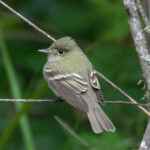 |
The Acadian flycatcher nests in all 100 North Carolina counties. It is found primarily in moist hardwood forests (always avoiding pines), usually near a creek or in bottomland forests, and less so in deep swamps. However, it is not a canopy bird, but it forages in the understory, usually about 20-50 feet above ground. Nests are often built on down-hanging branches directly over a creek. |
 |
The Bachman’s Sparrow is state listed North Carolina Special Concern. Habitat loss and fire suppression are considered the most significant threats to the Bachman’s sparrow. In general, prime habitat is mature pine stands that are frequently burned. Sparrows will abandon a site if fire is excluded for more than three years. For these reasons, in North Carolina this bird is found only in the coastal plain and is highly restricted to managed longleaf pine stands. |
 |
The Northern Cardinal is the official state bird of North Carolina. It is common to abundant across the state during all seasons. Although Northern Cardinals are common at nearly any bird feeder within their range they require dense shrubby areas such as woodland edges for breeding and nesting. They use many kinds of trees and shrubs, including dogwood, honeysuckle, hawthorn, grape, redcedar, spruce, pines, hemlock, rose bushes, blackberry brambles, elms, sugar maples, and box elders. |
 |
The Carolina Chickadee is a permanent non-migratory resident in all of North Carolina’s 100 counties. It is absent only on the barrier islands because they lack forests. Its year-round habitat is middle-aged to mature forests and woodlots, both in residential areas and in more remote areas. Carolina Chickadees nest and raise their young in either natural tree cavities or cavities left by woodpeckers. |
 |
The Brown Creeper is state listed North Carolina Special Concern. In our state, it nests in the middle and higher elevations of the mountains; it winters statewide. As it nests essentially only beneath loose bark on tree trunks — no other North American bird does that — it requires mature forests, usually spruce-fir, but also in mixed forests. |
 |
BALD EAGLE
(Haliaeetus leucocephalus)
In North Carolina, the bald eagle is listed as a threatened species. It prefers habitat near lakes, large rivers, and shorelines of sounds and bays, and requires tall, isolated trees for perching and nesting. The bald eagle needs a tall, living tree for its huge nest, preferably a tree with a stout vee or several branches making a sturdy crotch. |
 |
The Wood Duck is found statewide in North Carolina, but is most numerous in the coastal plain. As its name implies, it is most often found in wooded swamps, beaver ponds, freshwater marshes and long streams and rivers near forests. The wood ducks’ body and eyes are well adapted to this habitat. Its slim body allows it to fit into natural tree cavities to nest and its large eyes help the wood duck avoid limbs and branches as it flies through the canopy. |
 |
The Red-Tailed Hawk is native to North Carolina and is a common permanent resident. Generally, the red-tailed hawk prefers thick upland hardwood forests for nesting and roosting, and open fields for feeding. |
 |
BLUE JAY
(Cyanocitta cristata)
During all seasons, the Blue Jay favors mature hardwood or mixed forests and woodlands that are somewhat open, including wooded residential areas. Forests with a considerable number of oaks or beech are preferred. Drier forests are also preferred over swamps. |
|
|









